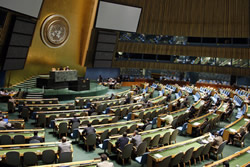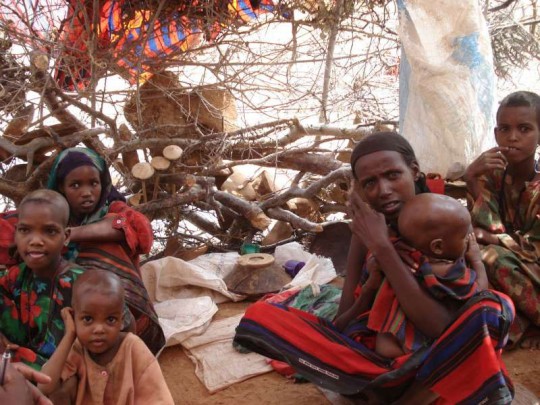Ethiopia opens additional camp for Somali refugees – UN agency
Ethiopia opens additional camp for Somali refugees – UN agency
The Bur Amino camp in Ethiopia’s Dollo Ado region was opened on Wednesday and has received the first group of some 400 Somali refugees so far, Andrej Mahecic, spokesperson for the UN High Commissioner for Refugees (UNHCR), told reporters in Geneva.
“The relocation to Bur Amino will decongest the transit centre,” said Mr. Mahecic. “For weeks, 7,500 recent arrivals from Somalia had been living in the centre, built to host one third of that population for a few days only.
“Rain and poor shelter conditions exacerbated the already low nutritional and health status of the refugees there, especially the children,” he added.
On arrival at the new camp, the refugees underwent health and nutrition screening before being shown to their tents and given hot meals. Those being relocated to Bur Amino will benefit from food distribution, supplementary feeding for malnourished children, water, health and sanitation facilities.
UNHCR and Ethiopian authorities are continuing with the gradual relocation, moving 500 refugees every four days as parts of the new camp are still being developed.
Ethiopia has received more than 98,000 Somali refugees since the start of this year, adding to an existing refugee population of some 41,000 in older camps.
Another 163,000 Somalis have arrived in Kenya and over 4,800 in Djibouti, bringing the total number of Somali refugees in the region to more than 950,000, according to UNHCR.
###
2 December 2011
Ethiopia opens new camp for Somali refugees
This is a summary of what was said by UNHCR spokesperson Andrej Mahecic – to whom quoted text may be attributed – at the press briefing, on 2 December 2011, at the Palais des Nations in Geneva.
Hundreds of Somali refugees in southern Ethiopia’s Dollo Ado region have been relocated from an overcrowded transit centre to a new camp, Bur Amino.
The camp was opened on Wednesday and became the fifth one in the Dollo Ado region. The first group of some 400 refugees has been moved by bus from the transit centre to Bur Amino, 26 kilometres away. On arrival, the visibly relieved refugees underwent health and nutrition screening before being shown to their tents and given hot meals.
The relocation to Bur Amino will decongest the transit centre. For weeks, 7,500 recent arrivals from Somalia had been living in the centre, built to host one-third of that population for a few days only. Rain and poor shelter conditions exacerbated the already low nutritional and health status of the refugees there, especially the children.
UNHCR and Ethiopian authorities are continuing with the gradual relocation, moving 500 refugees every four days as parts of Bur Amino camp are still being developed. Construction has been delayed primarily because the site’s rocky soil hampered the building of sanitation facilities.
Refugees at Bur Amino will benefit from food distribution, supplementary feeding for malnourished children, water, health and sanitation facilities.
Since the beginning of the year, Ethiopia has received more than 98,000 Somali refugees fleeing conflict and drought in their homeland, adding to an existing refugee population of some 41,000 in older camps. Another 163,000 Somalis have arrived in Kenya, and over 4,800 in Djibouti. In all, there are now more than 950,000 Somali refugees in the region.
###
About Office of the United Nations High Commissioner for Human Rights (OHCHR)
Who we are
The Office of the United Nations High Commissioner for Human Rights (OHCHR) represents the world’s commitment to universal ideals of human dignity. We have a unique mandate from the international community to promote and protect all human rights.
Leadership
The High Commissioner for Human Rights is the principal human rights official of the United Nations. The High Commissioner heads OHCHR and spearheads the United Nations’ human rights efforts. We offer leadership, work objectively, educate and take action to empower individuals and assist States in upholding human rights. We are a part of the United Nations Secretariat with our headquarters in Geneva.
The Office’s priorities are set out in two key strategic documents: the OHCHR Plan of Action and its Strategic Management Plan 2010-2011. These priorities include greater country engagement, working closely with our partners at the country and local levels, in order to ensure that international human rights standards are implemented on the ground; a stronger leadership role for the High Commissioner; and closer partnerships with civil society and United Nations agencies.
United Nations human rights system
We also support the work of the United Nations human rights mechanisms, such as the Human Rights Council and the core treaty bodies set up for monitoring State Parties’ compliance with international human rights treaties, promote the right to development, coordinate United Nations human rights education and public information activities, and strengthens human rights across the United Nations system. We work to ensure the enforcement of universally recognized human rights norms, including through promoting both the universal ratification and implementation of the major human rights treaties and respect for the rule of law.
Our structure
We have an office at United Nations headquarters in New York and offices in numerous countries and regions. In addition to the Executive Office of the High Commissioner and a number of units that report to the Deputy High Commissioner, OHCHR has two major divisions and four branches.
To implement our comprehensive mandate, we employ more than 850 staff (last update in April 2007), based in Geneva and New York and in 11 country offices and seven regional offices around the world, including a workforce of some 240 international human rights officers serving in UN peace missions. We are funded from the United Nations regular budget and from voluntary contributions from Member States, intergovernmental organizations, foundations and individuals.
###
> United Nations (UN).
 The United Nations was established on 24 October 1945 by 51 countries committed to preserving peace through international cooperation and collective security. Today, nearly every nation in the world belongs to the UN: membership totals 192 countries.
The United Nations was established on 24 October 1945 by 51 countries committed to preserving peace through international cooperation and collective security. Today, nearly every nation in the world belongs to the UN: membership totals 192 countries.
When States become Members of the United Nations, they agree to accept the obligations of the UN Charter, an international treaty that sets out basic principles of international relations. According to the Charter, the UN has four purposes:
- to maintain international peace and security;
- to develop friendly relations among nations;
- to cooperate in solving international problems and in promoting respect for human rights;
- and to be a centre for harmonizing the actions of nations.
###
* The above story is adapted from materials provided by United Nations (UN)
** More information at United Nations (UN)





















